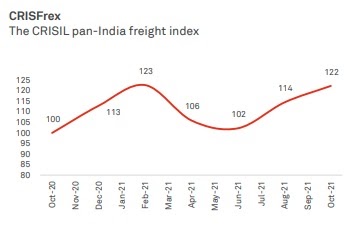CRISIL Freight Index moves up on broad recovery; demand to support freight rates
The Crisil Freight Index (CRISFrex) moved up to 122 in October, almost near its all-time high of 123 in February 2021 on broad based recovery across most route-commodity combinations.

November 24, 2021: The Crisil Freight Index (CRISFrex) moved up to 122 in October, almost near its all-time high of 123 in February 2021 on broad based recovery across most route-commodity combinations.
CRISFrex captures changes in freight rates on a sequential basis. "What makes it first-of-its-kind in India is that it also tracks the free cash flows, or FCF (pre-EMI) of transporters on an on-going basis. Higher FCF would typically lead to higher demand for commercial vehicles," according to the latest report.
 Ratings agency CRISIL incorporates views of 100-150 transporters to understand freight dynamics as well as operational aspects like the number of trips done and key cost heads (fuel, driver, toll, tyre and maintenance). "This exercise is conducted on a closed sample of 159 route-commodity combinations spanning 32 routes, 11 commodity types and five truck platforms with differing load bodies depending on the commodity carried. Our analysis depicts an aggregated view of the inputs collected to arrive at a holistic picture pertaining to the overall trucking scenario in India.”
Ratings agency CRISIL incorporates views of 100-150 transporters to understand freight dynamics as well as operational aspects like the number of trips done and key cost heads (fuel, driver, toll, tyre and maintenance). "This exercise is conducted on a closed sample of 159 route-commodity combinations spanning 32 routes, 11 commodity types and five truck platforms with differing load bodies depending on the commodity carried. Our analysis depicts an aggregated view of the inputs collected to arrive at a holistic picture pertaining to the overall trucking scenario in India.”
CRISIL started tracking freight rates regularly from October 2020. Hemal N Thakkar, director, Crisil, told ITLN: "We used to do it sporadically initially, and we came across the fact that there is no credible data source which put this out on an on-going basis. And, you know, CRISIL being a company largely driven by data and analytics, we thought putting out only data does not make sense.It needs to be backed by proper analysis. So, what we did was we interacted with many people in the industry and tried to understand a few commodities that are very critical from a transport perspective. So, we zeroed in on 32 routes, which, as per our understanding, contribute to about 60 percent of the overall country's traffic. We also looked at key commodities moving on those routes. So, based on various hubs, we've chosen those commodities. So, for example, when you look at Hyderabad, cement is very prominent. When you look at NCR, autos are prominent, agri is prominent. We considered that and then we married it with the type of vehicle that typically transports these kinds of goods.”
Talking about large corporates in and around the Delhi and NCR area, Thakkar said: "Most of the large manufacturers have structured contracts. You could talk about a Maruti or Honda or Hero MotoCorp - they will have contracts for transporters where there are escalation clauses.. if diesel prices increase by x, freight rates should go up by y. So, they may actually not face a larger challenge but medium and small enterprises auto component companies may face some challenge because they may have to, kind of get trucks on what you call the spot market, and they need to understand how things are on the clock."
Thakkar added that “we were surprised to see that there is a lot of interest for our report from tyre manufacturers. So, they are like you know, roads where there is higher traffic, there will be higher replacement. So, people are looking at the report in a very different way... people are comprehending it in a different manner."
Infra pick-up boosts freight rates
Consumption recovery and infrastructure activity picking up with monsoon withdrawal saw freight rates move up but with diesel prices ruling high after a scorching run-up, the overall profitability of transporters remains below levels seen in the closing quarter of the last fiscal.
The recovery has been broad-based, with most route-commodity combinations seeing an increase in freight rates. In October 2021, ~80-85 percent combinations saw an improvement in freight rates over August 2021, while ~15-20 percent were unable to pass on the diesel price hikes due to demand-supply considerations.
Freight rates perk up
Freight rates for haulage of industrials like cement have been relatively firm, the report said. "Movement of consumption-related goods such as FMCG/FMCD (fast moving consumer durables) and agri-products has been relatively firm as well. Applications such as textiles (especially readymade garments) have been struggling as demand may take another few months to revive to pre-pandemic levels."
Dec-20 | Feb-21 | Apr-21 | Jun-21 | Aug-21 | Oct-21 | |
Increase in freight rates | 115 | 129 | 20 | 66 | 147 | 132 |
Decrease in freight rates | 44 | 30 | 138 | 93 | 12 | 15 |
Similar to previous month | 0 | 0 | 1 | 0 | 0 | 12 |
Total | 159 | 159 | 159 | 159 | 159 | 159 |
Despite improvement in the index in October 2021 to 122 (similar to February 2021 levels), the FCF still continues to be at a level (17 percent) comparable with October 2020. "This is one of the key reasons that financiers are still not comfortable in funding small fleet operators."
“With diesel prices coming down, the sense we are getting is probably freight rates have not dropped by that much..freight rates drop is lower as compared to drop in diesel prices, which means, hopefully, transporters' cash flows would improve further,” Thakkar added. “We will come to know by the end of this month when we get inputs, insights on how things have shaped up for the entire month.”
Outlook for remaining fiscal and 2022
"We started tracking freight rates from October 2020. We're not only tracking freight rates, we are also looking at the cash flows that the past quarters generated on particular routes on an on-going basis. We are looking at the number of trips the transporter makes on an on-going basis, and we are in a position to give a sense as to how things are shaping up on the ground.”
Thakkar was very clear when he said it is very difficult to forecast because “it is largely dependent on diesel prices. These are more political decisions, which will influence freight rates. If you ask me, from a demand supply-dynamics perspective, we still feel demand continues to be strong, and demand will continue to support the overall freight movement going forward. So, from that perspective, we are not seeing much of a challenge but when it comes to fuel prices, nobody can predict..maybe the freight index in November may look lower than the freight index of October but the cash flow may look better. What matters is cash flow and not only the freight index.”

Jyothi Shankaran
Associate Editor, STAT Media Group. He has worked with IndiaSpend, Bloomberg TV, Business Standard and Indian Express Group. Jyothi can be reached at jyothi@statmediagroup.com


